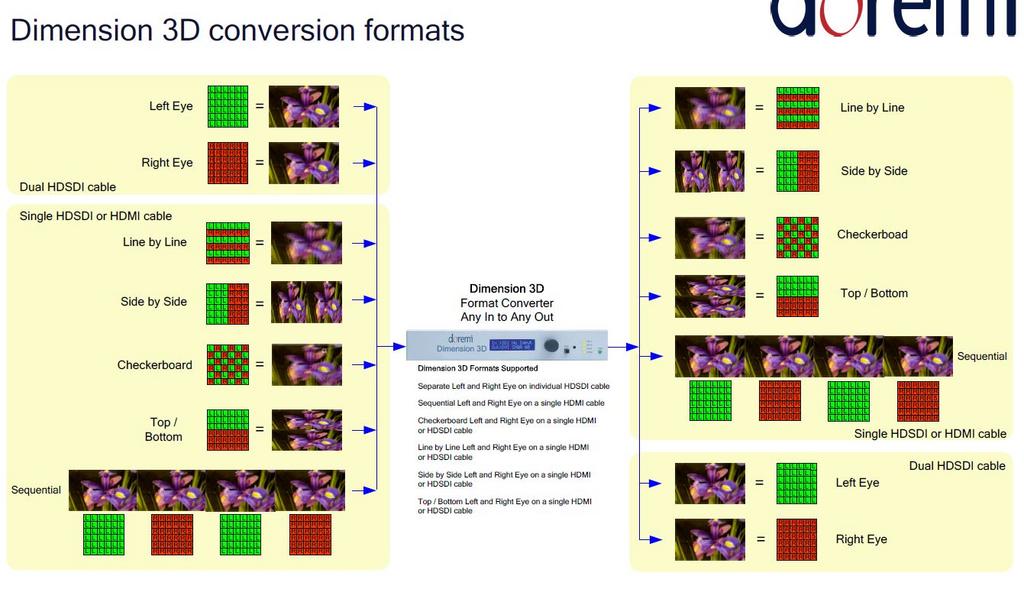@Lee_A_Stewart I know 3D formats can be converted between each other. There's free software called Bino3d available at
http://bino3D.org So yes, with enough horsepower 3D is technically 2D compatible. But do you know that some knuckle-draggers were complaining about a $10 box to turn HDTV broadcasts into an SDTV signal.
The only reason the government subsidized 80% of the $50 retail priced converters was that the government was claiming back frequencies and bandwidth lost by SDTV. I doubt the US federal government would subsidize a 3D-to-2d converter. They have nothing to gain with 3D.
Then the question for federal airwaves is how to serve the public the best. Color was best when it didn't step on B/W's toes. Now that every camera is an HD camera, they usually have surround a spherical mic on them to capture surround sound. So even directionally and sonically mundane shows like The Price is Right and Wheel Of Fortune have 5.1 sheerly by inertia. (they may be good shows in terms of home-audience participation, but in terms of showing off your surround sound system, they are very benign.)
Since most shows shoot at 30 Hz anyway, making a 30 Hsz x 2 eye standard is perfect if you can trick a non-3D TV into thinking a 30 Hz x 2 Eye broadcast is really a 30 Hz ( x 1 eye) broadcast. Then 2D folks are happy, 3D folks are happy. DVRs with 60 Hz recording can capture both eyes, yet show only one eye when 2D is desired, and 2 eyes when 3D is desired. Also those funny wheel spinning artifacts on The Price Is right would be removed, assuming my theory is correct, which I can't assume.
@Frank169 I agree the way things look best in 3D is if they are relatively close up. If the shift in perspective is so minor between L only and R only that only a computer can tell, then it's a bad event to film in 3D.
That's why my best friend's wedding looks decent in 3D. (And I'm given so few tools that most of it was a "manual side-by-side half" that i couldn't guarantee the corresponding columns were aligned right. A friend who said that Avatar was the only binocularly filmed 3D movie since 2000, and said LITERALLY everything else was computer processed, thought, even though my 3D was off, [that's because I don't have proper tools] saw more convincing 3D, despite its flaws, than most hollywood blockbusters.)
Most shots are good when close up.
Another 3D filming technique: if you want to convey 3D over a distance, use a lot of motion in your shots. Filming my friend and his wife first dancing as a married couple looked more interesting when moving the camera. 3D does not look good sitting on a tripod. Motion shots is one key to making distance shots look more 3D and more believable in 3D.
That's why I thought of the prefect event to capture in 3D: A Miniature Golf tournament. Compared to large scale golf, Basketball, American football, and Soccer Football, Miniature Golf is kept in a phone booth. Also there is a natural 3-dimensionalism in the courses themselves. All the sports are a lot less 3 dimensional. (Large Scale Golf has some hilliness, but in terms of hilliness, Miniature Golf is Large Scale Golf with Monosodium Glutamate. Everything else LITERALLY takes place on a flat plane.)
Finally, the one thing you can't do with a 3DS camera is zoom. You might be able to zoom with a 3D cellular camera, but I doubt how good it is. Assuming the binocular separation distance is a constant, looking at something close up with a z-axis zoom without having a corresponding between-eye "y-axis zoom" throws off the scale. Zooming in makes things seem Godzilla-sized assuming the binocular separation distance doesn't get closer. Likewise starting zoomed in with the effect being right from a human perspective and zooming back gives you a Godzilla's-eye view of Tokyo, New York, or whatever major city he's closest to.
That's why, unless you're making a movie with major fantastical elements, like skyscraper-sized monsters, you should stick to the "walking zoom" if you don't want to throw off the 3D realism.
And that's the exact reason why most blockbusters usually have their human people captured monoscopically.
And probably more directors think the zoom is a more powerful tool than 3-dimensionalism. And if one wants both, one will have to a) get special non-basic 3D cameras where the relative distances of the 2 eyes can shift, b) use post-produced 3D computer tricks on monocular capture, and/or c) do "physical zooms", i.e. wheel the camera on a cart and physically go forward rather than optically.





















 Linear Mode
Linear Mode

